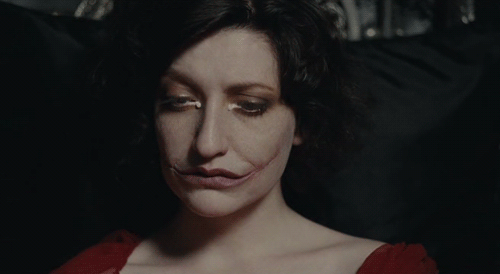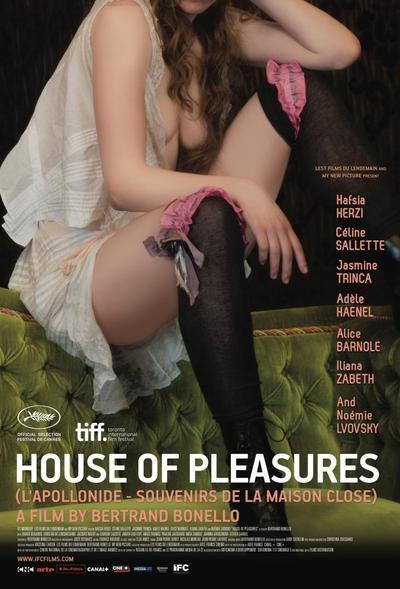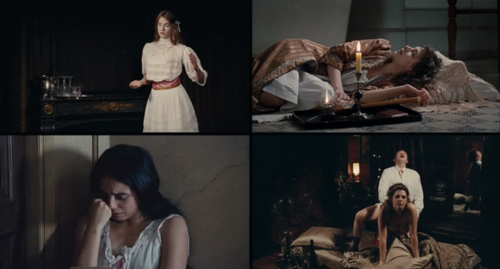
House of Pleasures (also called House of Toleration or L’Appolonide: Souvenirs de la Maison Close in its native France), directed by Bertrand Bonello, is a film depicting the last year of a legal French brothel, a maison close, at the turn of the 20th century. While the film does predictably illustrate the old prostitution-is-inherently-miserable motif, sex working viewers will find much to enjoy in the close examination of brothel history and the dynamics of women’s spaces that the movie offers. Then, of course, there are the costumes and the intense outfit envy they engender in any hooker with a pulse. The brothel workers wear diaphanous, clinging gowns that look like proper dresses in shadow but reveal their transparent naughtiness in candle light, and look even more temptingly gorgeous draped along with their wearers on the lush upholstered furniture of the maison. These elements, along with the sharp dialogue that director Bonello gives the workers, kept me watching, even when the crude, supposedly “feminist” analysis and the all-too-voyeuristic violence against sex workers he inserted into the movie made me want to hurl my remote control at the screen.
C’mon! Take this scene, for example:
Client: [After long, tedious description of the plot of H.G. Wells’ War of the Worlds—this guy is obviously the Victorian antecedent of people who blurt out spoilers] Have you read it?
Brothel Worker: No. My only two books are Sade’s diaries and the Bible, and I don’t read the Bible.
My kind of girl!
And at first I thought that House of Pleasures might provide the audience a nuanced economic analysis of its protagonists’ work: Early on in the movie, it’s made clear through a close up of the madam’s ledger book and the women’s anxious conversation among themselves that most of the workers are deeply in debt to the house. Throughout the narrative, the women and the brothel itself struggle to survive in the face of the crushing reality of a raised rent. There are even some interesting insights about the unpaid emotional labor involved in the work, as it’s implied that in this upscale environment, what’s being sold as much as the sexual services themselves is a cheerful, carefree attitude of refined femininity. While the women tally their success at the end of the night by the number of men who took them upstairs, they must linger for hours in calculated languidness downstairs, making conversation and cozying up with idle clients, playing board games with them and seeing how many party tricks can be performed with a champagne flute. “Try to be joyful,” the madam chides them at the beginning of the evening.

I also liked how the story of Pauline, a 16-year-old girl who briefly works at the brothel, isn’t turned into a melodrama about child sexual abuse—she writes to the brothel seeking employment of her own volition to make money, gets what she wants out of her brief stay there, being careful not to get into debt, then leaves. And I was pleasantly surprised by how the depiction of opium use in the house by clients and workers alike is not modified by modern attitudes about drug use but shown accurately as existing on a spectrum between the recreational and the problematic, true to how prevalent opium use was at the time, especially among the demimonde. But ultimately, all this studious attention to the material realities of the brothel workers’ lives is marred by sighing comments the script stuffs into the women’s mouths about how prostitution is innately negative.
Yet, debt slavery was endemic to many different professions in the Victorian era, not just sex work. And really, the film functions more accurately as a denunciation of the legalization model of prostitution over the decriminalization model, not as the screed against the exploitative nature of sex work itself that it clearly wants to be. For how did houses of toleration differ significantly from contemporary Nevada brothels? Workers not allowed to leave the grounds because it would be interpreted as “solicitation”? Check. Sold necessities at an inflated price by the owner and thus driven to debt? Check. Tested regularly by the house doctor yet given no good methods of STI prevention? True until relatively recently.
 But one thing Bonello does get right is his evocation of a cloistered women’s environment. We watch the women eating together, going on an outing to the waterfront, talking shit about their clients and gossiping about the other women, doing up each other’s dresses and lending each other makeup before the evening begins. Anyone who has ever worked alongside other sex workers will feel a pang of identification at these scenes. There even seems to be a sincere attempt to portray the way the world at large is hostile to us: the scene I found most resonant was the shot of one of the workers crying as she reads a typical phrenological treatise of the times—An Anthropometric Study of Prostitutes and Female Thieves, by Dr. Pauline Tarkowsky—which informs her that it’s been scientifically proven that prostitutes have smaller heads, and thus less brain matter, making them mentally abnormal, stuporous, and idiotic. Just transpose the volume she’s holding in her hand with Gail Dines or Julie Bindel and this scene is as contemporary as it is painful.
But one thing Bonello does get right is his evocation of a cloistered women’s environment. We watch the women eating together, going on an outing to the waterfront, talking shit about their clients and gossiping about the other women, doing up each other’s dresses and lending each other makeup before the evening begins. Anyone who has ever worked alongside other sex workers will feel a pang of identification at these scenes. There even seems to be a sincere attempt to portray the way the world at large is hostile to us: the scene I found most resonant was the shot of one of the workers crying as she reads a typical phrenological treatise of the times—An Anthropometric Study of Prostitutes and Female Thieves, by Dr. Pauline Tarkowsky—which informs her that it’s been scientifically proven that prostitutes have smaller heads, and thus less brain matter, making them mentally abnormal, stuporous, and idiotic. Just transpose the volume she’s holding in her hand with Gail Dines or Julie Bindel and this scene is as contemporary as it is painful.
Ultimately, though, the film’s perspective is not that of an insider, but that of a voyeur. The most inventive cinematography and the majority of the film is reserved for portraying the women’s sessions with clients. We get the full range of gorgeously shot fetish scenes, among them a man who wants his lover to move like a doll with wooden joints, as well as a totally unnecessary Orientalist scene, complete with appropriative geisha kimono, in which the client asks the white French worker thus costumed to talk to him in Japanese sounding gibberish. (Would a brothel in that era realistically have run into that sort of kink and accommodated it? Sure. But why film it unless you want to enjoy some sexualized yellowface supposedly permitted by historical accuracy?) While the clients are realistically portrayed as running the gamut from truly caring to vicious, within the first fifteen minutes of running time, one of the women, Mathilde, “The Jewess,” is maimed by a client she knows well. As the rest of the brothel’s working life continues unknowingly, we see her screaming with blood streaming all over her face, her client having slashed her mouth into a Jokeresque perpetual smile.
The movie returns to this scene and its precursor—Madeline agreeing to allow the client to tie her up, the erotic knife play that preceded his sudden violation—over and over again throughout as Madeline remembers it. While the way she returns to the scene of the crime in her thoughts is an accurate representation of the recursive nature of traumatic memory, and the implication that she feels ashamed because at first she was aroused by what seemed to be just another kinky session rings true to many survivors’ experiences, the way the camera lingers over this sequence time and time again made me incredibly uncomfortable with its sexualization of a woman’s assault. I do have to admit, though, it is fascinating to follow how Madeline then deals with the destruction of one of her major means of production—her looks: the way she overhears the madam negotiating with a rubbernecking client who just wants to pop into her room and look at her; the way she’s demoted to the brothel’s housekeeper so she can still stay on, given how she almost never gets business anymore; the way it’s apparent that she hates recounting the tale of her assault to a client who feels he’s bought the right to her sad story as well as her services (“Are we going to make love or not? I don’t want to talk anymore”); and finally, how she has to fetishize her mutilation for a “special evening” set up for some sybarites, which the brothel fixes up in a desperate attempt to remain solvent.

But what conclusions are we supposed to draw from this narrative, anyway? That even the most trusted regular can fuck you over in a permanent and painful way, because them’s just the breaks of whoring, girls? We already know that, and we also know that this problem is structural, and not innate. But the film makes no attempt to analyze Madeline’s story with any more complexity than “patriarchy bad, hooking sucks.” In the end it seems gratuitous. A fellow sex worker who also watched the movie and has studied French cinematography in depth told me that the disfigured prostitute is a common trope in French brothel movies, so perhaps I’m mistaken here by considering House of Pleasures outside of that cultural history, but nevertheless, it seems like more of the same: sex working women being hurt for a male audience’s viewing pleasure.
When we hit the epilogue, House of Pleasures cements the banality and reductionism of its perspective on sex work. The last shot is an actress that played a brothel worker throughout the rest of the movie portraying a sad, scruffy looking street sex worker waiting on the side of a grimy highway for passing cars. Not only is this footage all too typical—how many times have we seen sex work reduced to this iconography in how many “gritty” investigative features, the headless scantily clad street sex worker teetering on her heels and leaning over a car window, under a dimly lit streetlight in some depressing urban backdrop?—but it also makes no socioeconomic sense. If Bonello wanted to draw a contemporary parallel to the employees of the maison close, an upscale escort would have been appropriate, or, even more accurately, again, a high earning Nevada brothel worker. All this stereotypical scene of street work does is say, “Hey, look, they’re both prostitutes, and they’re both inevitably unhappy!” Not exactly complex or probing analysis, here.
So, as art that presents any new insight on sex worker history, House of Pleasures fails miserably. (And prospective viewers should also take note that beyond all its reactionary elements, the movie is certainly as French as French can get, with all that can entail—people have dreams about crying tears of sperm and talk in extended metaphors about their tongues slithering across the floor.) But as a fun feast for the senses, and as a glimpse of women working together that most sex workers can relate to, it can make for an absorbing two hours.
A note–a French sex worker activist commented in reply to my posting this review on my Facebook page:
” about the end: “If Bonello wanted to draw a contemporary parallel to the employees of the maison close, an upscale escort would have been appropriate, or, even more accurately, again, a high earning Nevada brothel worker. All this stereotypical scene of street work does is say, “Hey, look, they’re both prostitutes, and they’re both inevitably unhappy!” I dont agree, the equivalent of a XIX century brothel worker is a street based sex worker in france. In France, a very large number of sex workers work in the streets, roads, forests …and it is the direct result of the closing down of brothel in 1946. France is extremely abolitionist and is unable to realise that it has some of the worst working conditions for sex workers in western europe, really hig level of violence etc… so i really see the last scene of the movie as a question to the viewers ” is it really better now?” ( with implied response “no” )”
Other viewers who commented on Facebook agreed with him, and after consideration, I have to agree with their alternate interpretation of the end of the movie–which does soften my judgement of Bonnello’s treatment of sex work. But the other problems I write about having with the movie remain.
…I wasn’t thinking about the epilogue in enough of a solely French context, obviously.
Hey, thanks for this review! I vividly remember how frustrated I was at that last scene with the street hooker; I’m glad to get the French contextualization.
But. One of the best things about House of Pleasures: the black panther they keep in the brothel.
Ha, yes, it was certainly a failure of this review to not mention that panther! And also, what they ultimately have the animal do…
One defense is that I suspect most women (maybe most people) at that time of history were either miserable, or in that numb state that many can retreat into as a way of avoiding blatant misery. As long as they didn’t do the “ray of hope as one fallen woman is saved by a kindly client” thing.
Yeah, well, one of the brothel workers does have a client pay off her debts and presumably becomes a kept woman as the brothel closes, but it’s just presented as a different sort of sex work. I’m not sure all women were miserable at the time–even in oppressive circumstances, many people find a way of thriving, and also I’m sure having other privilege helped for some—but I see your point.
Such an articulate review 🙂